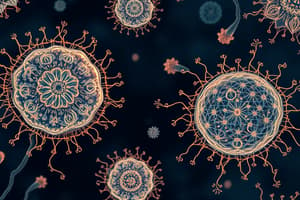Podcast
Questions and Answers
What characteristic differentiates prokaryotic flagella from eukaryotic flagella?
What characteristic differentiates prokaryotic flagella from eukaryotic flagella?
- Eukaryotic flagella do not have a structure
- Eukaryotic flagella have a 9+2 structure (correct)
- Prokaryotic flagella are shorter than eukaryotic flagella
- Prokaryotic flagella contain a 9+2 structure
Which of the following is a feature that distinguishes eukaryotes from prokaryotes?
Which of the following is a feature that distinguishes eukaryotes from prokaryotes?
- Eukaryotes can fix nitrogen
- Eukaryotes have nuclear membranes (correct)
- Prokaryotes reproduce sexually
- Prokaryotes have peptidoglycan in their cell walls
Which group of organisms is known for a critical role in coral reef building and can grow to significant depths?
Which group of organisms is known for a critical role in coral reef building and can grow to significant depths?
- Green algae
- Blue-green algae
- Prokaryotes
- Red algae (Rhodophyta) (correct)
Which of the following statements regarding algae is true?
Which of the following statements regarding algae is true?
What type of reproduction is commonly associated with eukaryotes?
What type of reproduction is commonly associated with eukaryotes?
What material is commonly found in the cell walls of prokaryotes?
What material is commonly found in the cell walls of prokaryotes?
What is the primary way in which nitrogen fixation occurs in the context of prokaryotes?
What is the primary way in which nitrogen fixation occurs in the context of prokaryotes?
Which description best applies to the life cycle of algae?
Which description best applies to the life cycle of algae?
Where are red algae most abundantly found?
Where are red algae most abundantly found?
Which of the following statements about eukaryotic nuclear division is correct?
Which of the following statements about eukaryotic nuclear division is correct?
Flashcards
Prokaryotes
Prokaryotes
Single-celled organisms lacking a nucleus and other membrane-bound organelles.
Eukaryotes
Eukaryotes
Organisms with cells that have a nucleus and other membrane-bound organelles.
Peptidoglycan
Peptidoglycan
A polymer found in bacterial cell walls.
Algae
Algae
Signup and view all the flashcards
Rhodophyta
Rhodophyta
Signup and view all the flashcards
Mitosis or Meiosis
Mitosis or Meiosis
Signup and view all the flashcards
Sexual Reproduction
Sexual Reproduction
Signup and view all the flashcards
Unicellular Algae
Unicellular Algae
Signup and view all the flashcards
Multicellular Algae
Multicellular Algae
Signup and view all the flashcards
Study Notes
Prokaryotes vs. Eukaryotes
- Cell wall: Prokaryotes typically have a cell wall containing peptidoglycan; Eukaryotes lack peptidoglycan.
- Nuclear division: Prokaryotes divide without a membrane-bound nucleus using a different process than Eukaryotes (mitosis/meiosis).
- Sexual reproduction: Eukaryotes typically reproduce sexually; Prokaryotes don't commonly have this process, though some bacteria do.
- Flagella: Prokaryotic flagella lack the 9+2 microtubule structure, while eukaryotic flagella have it.
- Nitrogen fixation: Some prokaryotes (e.g., bacteria and blue-green algae) can fix nitrogen; eukaryotes like plants and animals cannot fix nitrogen.
Algae Characteristics
- Diversity: Algae range from tiny single-celled organisms to large multicellular seaweeds.
- Definition: Algae are photosynthetic organisms.
- Structure: Algae do not have specialized roots, stems, or vascular bundles.
- Embryo Stage: Algae lack a diploid embryo stage.
- Reproductive Structures: They don't have sterile tissue around their reproductive structures.
- Zygote Development: Zygote development typically occurs through mitosis or meiosis, bypassing embryo formation.
Rhodophyta (Red Algae)
- Distribution: Abundant and diverse in warm tropical and subtropical regions. Also present in temperate and polar seas, and some hot springs.
- Coral Reefs: Critical role in building coral reefs.
- Carbonate Deposits: Important role in global carbon storage, with carbonate deposits.
- Photosynthetic Capacity: Deepest photosynthetic eukaryotes.
- Pigments: Marine forms are recognized by bright pink color from phycoerythrin and phycocyanin pigments.
General Characteristics of Red Algae (Rhodophyta)
- Morphology:
- Most species have multicellular, macroscopic thalli with diverse forms.
- Forms can include uniaxial and multiaxial forms depending on filament arrangement.
- Thallus: Thallus of red algae are delicate compared to brown algae.
- Motility: Lack motility.
- Cell Division & Cytokinesis: 90% of their cells don't divide completely. The open regions get plugged by proteins. Cytoplasmic connections CAN be re-established, and eventually are plugged with proteins. Secondary pit connections lend strength to filaments.
- Reproductive Forms: Employ vegetative and asexual reproduction.
Cell Wall Structure
- Components: Cell walls are composed of cellulose fibers (rigid) and gels of sugar polymers (flexible).
- Importance: These parts are essential structural components of plant cells.
Plastids
- Morphologies: There are two major types of plastid morphologies in red algae: axial and stellate, and parietal and discoidal.
Storage Products
- Floridean Starch: A unique starch form found in red algae, lacking amylose and possessing highly branched amylopectin in an alpha-1,4 polymer.
Studying That Suits You
Use AI to generate personalized quizzes and flashcards to suit your learning preferences.




